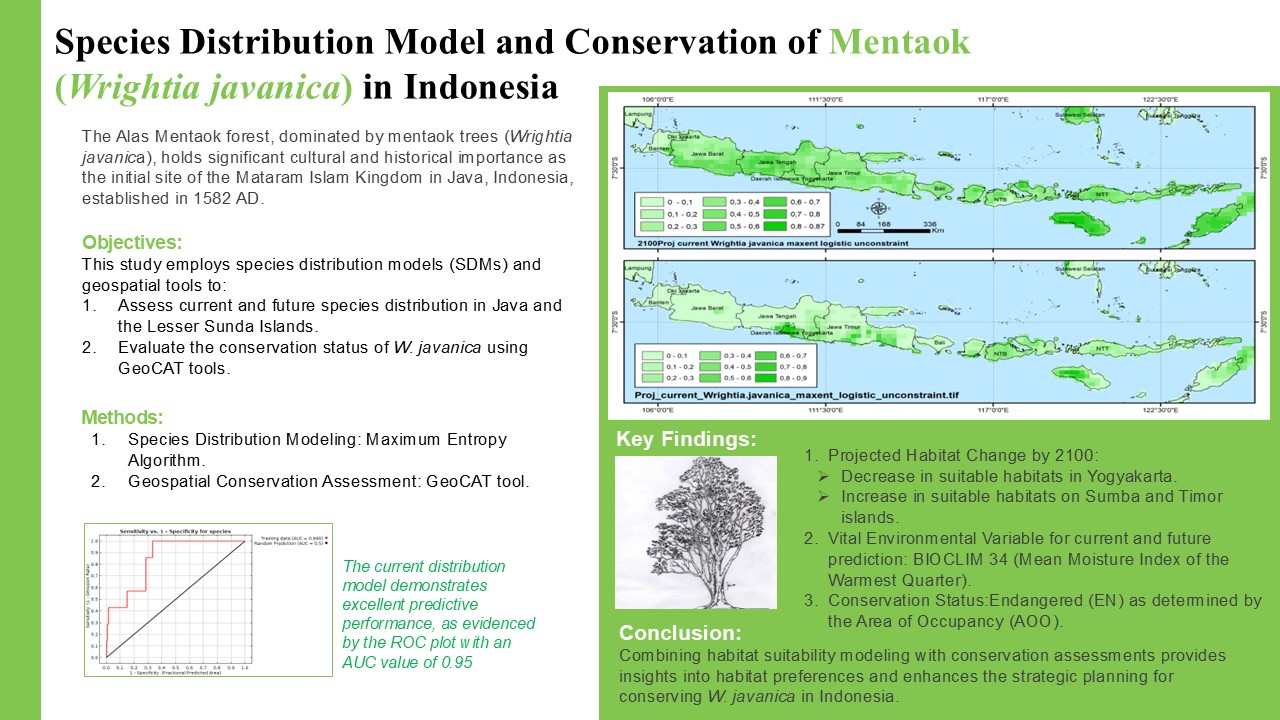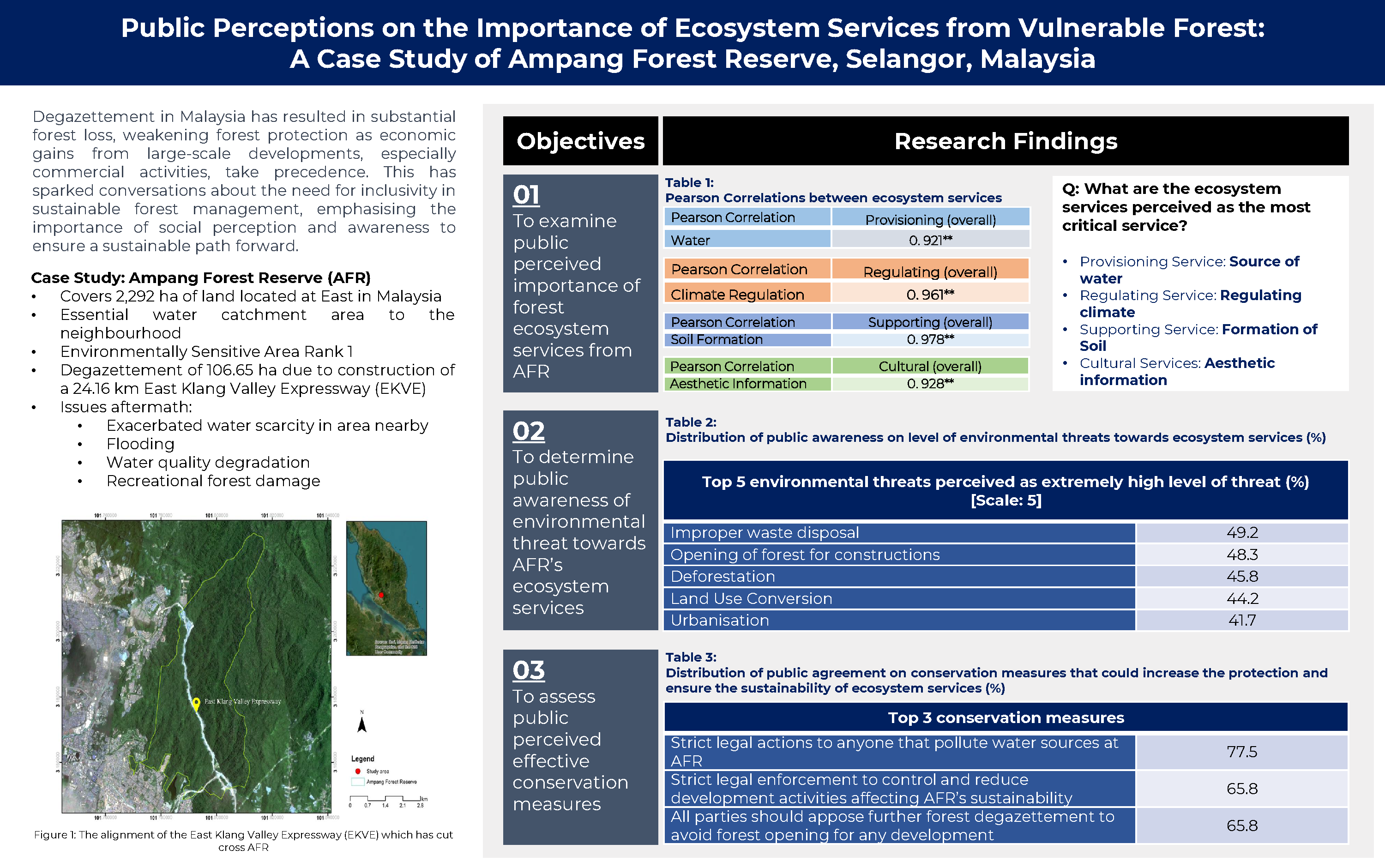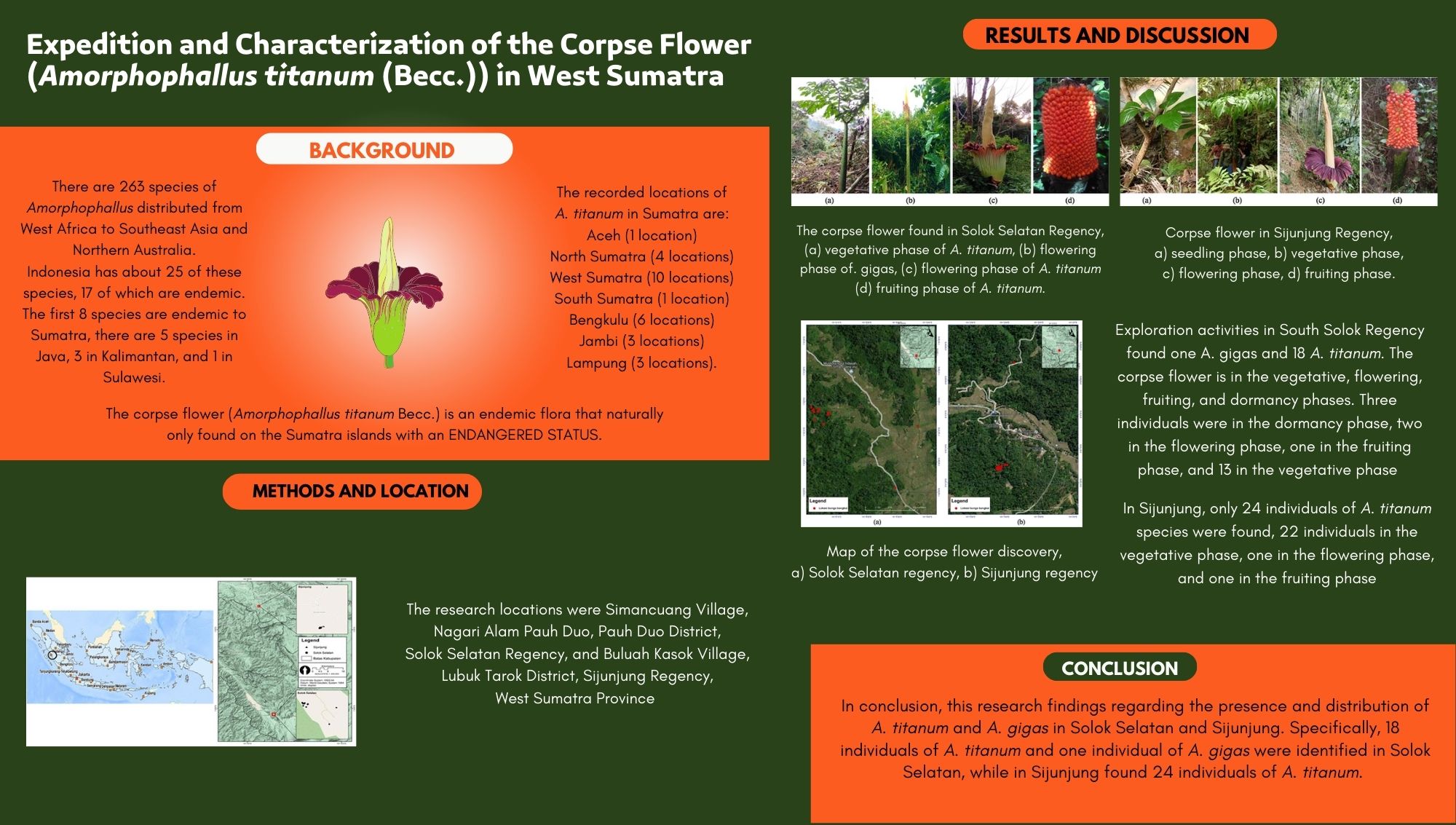Habitat Suitability Modeling of Javan Slow Loris (Nycticebus javanicus) in the Forest Cluster of Gunung Halimun Salak
Abstract
Javan slow loris (Nycticebus javanicus) is one of the endemic wildlife on Java Island. This species owns particular characteristics, including arboreal, solitary, and nocturnal natures. The species is threatened due to habitat loss and illegal trafficking. Nevertheless, their current geographic distribution remains unclear and environmental factors impact on these species is mostly unknown. This study aims to predict the habitat suitability of javan slow loris in the Conservation Management Forest Unit area of Mount Halimun Salak Forest Group. The study employs a species distribution modeling approach using Maximum Entropy. The presence data of javan slow loris was collected from the radio-telemetry devices used in post-release monitoring. The modeling utilizes elevations, distance from the settlements, slopes, and land covered as its environment variables. The result shows that 52% of the study areas, or 54,669 ha are suitable as the habitat of N. javanicus. Since as the largest protected area on Java Island, Gunung Halimun Salak National Park is one of the natural habitats that are pivotal for this species. This study provides essential documentation for developing management strategies within protected areas. Hence, the result of the study could serve as one of the factors in the determination of animal release location in the future.
References
Arismayanti, A., Perwitasari, R. D., & Winarti, I. (2018). The home range and space utilization of javan slow loris (Nycticebus javanicus) in Gunung Halimun Salak National Park. Jurnal Sumberdaya Hayati, 4(2), 28–41. https://doi.org/10.29244/jsdh.4.2.28-41
Austin, M. (2007). Species distribution models and ecological theory: A critical assessment and some possible new approaches. Ecological Modelling, 200(12), 1–19. https://doi.org/10.1016/j.ecolmodel.2006.07.005
Basalamah, F., Zulfa, A., Suprobowati, D., Asriana, D., Susilowati, Anggraeni, A., & Nurul, R. (2010). Status populasi primata di Taman Nasional Gunung Gede Pangrango dan Taman Nasional Gunung Halimun Salak, Jawa Barat. Jurnal Primatologi Indonesia, 7( 2), 55–59.
Cabana, F., Dierenfeld, E., Wirdateti, W., Donati, G., & Nekaris, K. A. I. (2017). The seasonal feeding ecology of the javan slow loris (Nycticebus javanicus). American Journal of Physical Anthropology, 162(4), 768–781. https://doi.org/10.1002/ajpa.23168
Dormann, C. F., Elith, J., Bacher, S., Buchmann, C., Carl, G., Carré, G., …, & Leitão, P. J. (2013). Collinearity: A review of methods to deal with it and a simulation study evaluating their performance. Ecography, 36(1), 27–46. https://doi.org/10.1111/j.16000587.2012.07348.x
Franklin, J. (2010). Mapping species distributions: Spatial inference and prediction (Ecology, biodiversity and conservation). Cambridge: Cambridge University Press. https://doi.org/10.1017/CBO9780511810602
Fransson, L. (2018). Fine scale habitat and movement patterns of javan slow loris (Nycticebus javanicus) in Cipaganti, West Java, Indonesia. Sweden: Committee of Tropical Ecology, Uppsala University.
Giri, M. M. S., & Munawir, A. (2021). The habitat suitability analysis and the determination of locations for released wildlife in Gunung Halimun Salak National Park for the duration of 2021–2025. Jakarta: Direktorat Jenderal Konservasi Sumber Daya Hutan dan Ekosistem. Kementerian Lingkungan Hidup dan Kehutanan.
Giri, M. M. S., Pairah, Sodahlan E., Sahid, A., Ekariono, W., Ambarita, E., & Sutisna, C. (2019). Keanekaragaman primata di areal operasi panas bumi, Taman Nasional Gunung Halimun Salak. Jurnal Primatologi Indonesia, 16(1), 3–9.
Hendrian, A., Hendrayana, Y., & Supartono, T. (2020). Aktivitas harian kukang jawa (Nycticebus javanicus) pasca habituasi di Suaka Margasatwa Gunung Sawal Ciamis. Prosiding Seminar Nasional Konservasi untuk Kesejahteraan Masyarakat I, 1(1), 37–44.
Hijmans, R. J., Cameron, S. E., Parra, J. L., Jones, P. G., & Jarvis, A. (2005). Very high-resolution interpolated climate surfaces for global land areas. International Journal of Climatology, 25(15), 1965–1978. https://doi.org/10.1002/joc.1276
Jenks, G. F. (1967). The data model concept in statistical mapping. International Yearbook of Cartography, 7, 186–190.
Jiang, Z., Huete, A. R., Chen, J., Chen, Y., Li, J., Yan, G., & Zhang, X. (2006). Analysis of NDVI and scaled different vegetation index retrievals of vegetation fraction. Remote Sensing of Environment, 101(3), 366–378. https://doi/org/10.1016/j.rse.2006.01.003
[KLHK] Kementerian Lingkungan Hidup dan Kehutanan. (2017). Keputusan Menteri Lingkungan Hidup dan Kehutanan Nomor SK.628/MENLHK/SETJEN/PLA.2/11/2017 tanggal 10 November 2017 tentang Penetapan Wilayah Kesatuan Pengelolaan Hutan Konservasi Kelompok Hutan Gunung Halimun Salak terletak di Kabupaten Bogor dan Kabupaten Sukabumi, Provinsi Jawa Barat dan di Kabupaten Lebak, Provinsi Banten seluas 105.072 Hektar Jakarta: Kementerian Lingkungan Hidup dan Kehutanan.
Lehtinen, J. (2013). Distribution of the javan slow loris (Nycticebus javanicus): Assesing the presence in East Java, Indonesia [thesis]. Oxford: Oxford Brookes Unversity.
Li, Y., Li, M., Li, C., & Liu, Z. (2020). Optimized maxent model predictions of climate change impacts on the suitable distribution of Cunninghamia lanceolata in China. Forests, 11(3), 302. https://doi.org/10.3390/f11030302
Mangunjaya, F. M., Prabowo, H. S., Tobing, I. S. L., Abbas, A. S., Saleh, C., Sunarto, ..., & Mulyana, T. M. (2017). Pelestarian satwa langka untuk keseimbangan ekosistem: Penuntun sosialisasi fatwa MUI No. 4, 2014 tentang fatwa pelestarian satwa langka untuk menjaga keseimbangan eksosistem. Jakarta: Lembaga Pemuliaan Lingkungan Hidup dan Sumber Daya Alam, Majelis Ulama Indonesia (MUI) Pusat.
Matondang, N. F., Dewi, B. S., & Winarti, I. (2018). Penggunaan ruang kukang sumatera (Nycticebus coucang) pelepasliaran International Animal Rescue Indonesia (IARI) di Hutan Lindung KPHL Batutegi Blok Kalijernih Tanggamus Lampung. Jurnal Sylva Lestari, 6(1), 39–49. https://doi.org/10.23960/jsl1640-50
McCarthy, J., Wibisono, H., McCarthy, K., Fuller, T., & Andayani, N. (2014). Assessing the distribution and habitat use of four felid species in Bukit Barisan Selatan National Park, Sumatra, Indonesia. Global Ecology and Conservation, 3, 210–221. https://doi.org/10.1016/j.gecco.2014.11.009
Moore, R. S., Cabana, F., & Nekaris, K. A. I. (2015). Factors influencing stereotypic behaviours rescued of animals from Asian animal markets: A slow loris case study. Applied Animal Behaviour Science, 166, 131–136. https://doi.org/10.1016/j.applanim.2015.02.014
Morueta-Holme, N., Fløjgaard, C., & Svenning, J. C. (2010). Climate change risks and conservation implications for a threatened small-range mammal species. PLoS ONE, 5(4), e10360. https://doi.org/10.1371/journal.pone.0010360
Muttaqin, L. A., Murti, S. H., & Susilo, B. (2019). MaxEnt (Maximum entropy) model for predicting prehistoric cave sites in Karst area of Gunung Sewu, Gunung Kidul, Yogyakarta. Proceedings SPIE Volume 11311, Sixth Geoinformation Science Symposium, 113110B. https://doi..org/10.1117/12.2543522
Nekaris, K. A. I., Blackham, G. V., & Nijman, V. (2007). Conservation implications of low encounter rates of five nocturnal primate species (Nycticebus spp.) in Asia. Biodiversity and Conservation, 17, 733–747. https://doi.org/10.1007/s10531-007-9308-x
Nekaris, K. A. I., Pambudi, J. A. A., Susanto, D., Ahmad, R. D., & Nijman, V. (2014). Densities, distribution and detectability of a small nocturnal primate (javan slow loris Nycticebus javanicus) in a montane rainforest. Endangered Species Research, 24(2), 95–103. https://doi.org/10.3354/esr00585
Nekaris, K. A. I., Poindexter, S., Reinhardt, K. D., Sigaud, M., Cabana, F., Wirdateti, W., & Nijman, V. (2017). Coexistence between javan slow lorises (Nycticebus javanicus) and humans in a dynamic agroforestry landscape in West Java, Indonesia. International Journal of Primatology, 38, 303–320. https://doi.org/10.1007/s10764-017-9960-2
Nekaris, K. A. I. (2014). Extreme primates: Ecology and evolution of asian lorises. Evolutionary Anthropology: Issues, News, and Reviews, 23(5), 177–187. https://doi.org/10.100/evan.21425
Nekaris, K. A. I., Shekelle, M., Wirdateti, Rode-Margono, E. J., & Nijman, V. (2020). Nycticebus javanicus (errata version published in 2021). The moore red list of threatened species 2020: e.T39761A205911512. https://doi.org/10.2305/IUCN.UK.2020-2.RLTS.T39761A205911512.en
Nijman, V., Spaan, D., Rode-Margono, E. J., & Nekaris, K. A. I. (2017). Changes in the primate trade in Indonesian wildlife markets over a 25-year period: Fewer apes and langurs, more macaques and slow lorises. American Journal of Primatology, 79(1): e22517. https://doi.org/10.1002/ajp.22517
Onojeghuo, A. O., Blackburn, A. G., Okeke, F., & Onojeghuo, A. R. (2015). Habitat suitability modeling of endangered primates in Nigeria: Integrating satellite remote sensing and spatial modeling techniques. Journal of Geoscience and Environment Protection, 3(8), 23–38. https://doi.org/10.4236/gep.2015.38003
Phillips, S. J. & Dudik, M. (2008). Modeling of species distributions with Maxent: New extensions and a comprehensive evaluation. Ecography, 31, 161–175.
Phillips, S. J., Anderson, R. P., & Schapire, R. E. (2006). Maximum entropy modeling of species geographic distributions. Ecological Modelling, 190(34), 231–259.
Phillips, S. J., Dudík, M., & Elith, J. (2009). Sample selection bias and presence-only distribution models: Implications for background and pseudo-absence data. Ecological Applications. 19(1), 181–197. https://doi.org/10.1890/07-2153.1
Pliosungnoen, M., Gale, G., & Savini, T. (2010). Density and microhabitat use of bengal slow loris in primary forest and non-native plantation forest. American Journal of Primatology, 72, 1108–1117. https://doi.org/10.1002/ajp.20875
Qiao, H., Feng, X., Escobar, L. E., Peterson, A., Soberón, J., Zhu, G., & Papes, M. (2018). An evaluation of transferability of ecological niche models. Ecography, 42, 521–534. https://doi.org/10.1111/ecog.03986
Rahayu, T. (2015). Perlindungan hukum terhadap satwa dari perdagangan liar (Studi pada Wildlife Rescue Center, Pengasih Kulon Progo Yogyakarta) [undergraduate thesis]. Yogyakarta: Universitas Islam Negeri Sunan Kalijaga.
Rahman, D. A., Gonzalez, G., Haryono, M., Muhtarom, A., Firdaus, A.Y., Aulagnier, S. (2017). Factors affecting seasonal habitat use and predicted range of two tropical deer in Indonesian rainforest. Acta Oecologica, 82, 41–51. https://doi.org/10.1016/j.actao.2017.05.008
Rahman, D. A., Rinaldi, D., Kuswanda, W., Siregar, R., Noorchasanatun, F., Hakim, F., ..., & Putro, H. R. (2019). Determining the landscape priority and their threats for the critically endangered Pongo tapanuliensis population in Indonesia. Biodiversitas, 20, 3584–3592. https://doi.org/10.1305/biodiv/d201217
Rahman, D.A. (2020). Ecological niche and potential distribution of the endangered Bos javanicus in south-western Java, Indonesia. THERYA, 11, 57–68. https://doi.org/10.12933/therya-20-840
Rahman, D. A., Condro, A. A., Rianti, P., Masy'ud, B., Aulagnier, S., & Semiadi, G. (2020). Geographical analysis of the Javan deer distribution in Indonesia and priorities for landscape conservation. Journal for Nature Conservation, 54, 125795. https://doi.org/10.1016/j.jnc.2020.125795
Rahman D. A, Condro A. A, Giri M. S. (2022a). Model distribusi spesies: Maximum entropy. Bogor: IPB Press.
Rahman, D. A., Santosa, Y., Purnamasari, I., Condro, A.A. (2022b). Drivers of three most charismatic mammalian species distribution across a multiple-use tropical forest landscape of Sumatra, Indonesia. Animals, 12(19), 2722. https://doi.org/10.3390/ani12192722
Rajagukguk, E. V. (2014). Efektivitas peraturan perdagangan satwa liar di Indonesia. Jurnal Wawasan Hukum, 31(2), 216–228.
Razgour, O., Rebelo, H., Di Febbraro, M., & Russo, D. (2016). Painting maps with bats: Species distribution modelling in bat research and conservation. Hystrix, 27(1), 11753. https://doi.org/10.4404/hystrix-27.1-11753
Romdhoni, H., Komala, R., Sigaud, M., Nekaris, K. A. I., & Sedayu, A. (2018). Studi pakan kukang jawa (Nycticebus javanicus Goeffroy, 1812) di Talun Desa Cipaganti, Garut, Jawa Barat. AL-KAUNIYAH: Journal of Biology, 11(1), 9–15. https://doi.org/10.15408/kauniyah.v11i1.4914
Sari, D. F., Budiadi, & Imron, M. A. (2020). The utilization of trees by endangered primate species javan slow loris (Nycticebus javanicus) in shade-grown coffee agroforestry of Central Java. IOP Conference Series: Earth and Environmental Science, 449, 012044. https://doi.org/10.1088/1755-1315/449/1/012044.
Shepherd, C. R., Sukumaran, J., & Wich, S. A. (2005). Open season: An analysis of the pet trade in Medan, North Sumatra, 1997–2001. Kuala Lumpur: TRAFFIC Southeast Asia.
Sinaga, M. W. A. & Masyud B. (2017). Pemanfaatan ruang dan perilaku harian kukang sumatera (Nycticebus coucang Boddaert, 1785) di Taman Hewan Pematang Siantar (THPS) Sumatera Utara. Media Konservasi, 22(3), 304–311.
Sodik, M., Pudyatmoko, S., Semedi, P., & Imron, M. (2019). Resource selection by javan slow loris Nycticebus javanicus E. Geoffroy, 1812 (Mammalia: Primates: Lorisidae) in a lowland fragmented forest in Central Java, Indonesia. Journal of Threatened Taxa, 11(6), 13667–13679. https://doi.org/10.11609/jott.4781.11.6.13667-13679
Sodik, M., Pudyatmoko, S., Semedi, P., Tafrichan, M., & Imron, M. (2020). Better providers of habitat for javan slow loris (Nycticebus javanicus E. Geoffroy 1812): A species distribution modeling approach in Central Java, Indonesia. Biodiversitas, 21(5), 1890–1900. https://doi.org/10.13057/biodiv/d210515
Supriatna, J. (2006). Conservation programs for the endangered javan gibbon (Hylobates moloch). Jakarta: Conservation International Indonesia and Department of Biology, University of Indonesia..
Swets, J. (1988). Measuring the accuracy of diagnostic systems. Science, 240, 1285–1293.
Thorn, J. S., Nijman, V., Smith, D., & Nekaris, K. A. I. (2019). Ecological niche modelling as a technique for assessing threats and setting conservation priorities for asian slow lorises (Primates: Nycticebus). Diversity and Distributions, 15, 289–298. https://doi.org/10.1111/j.1472-4642.2008.00535.x
Tsoar, A., & Kadmon, R. (2007). A comparative evaluation of presence only methods for modelling species distribution. Diversity and Distributions, 13, 397–405. https://doi.org/10.1111/j.1472-4642.2007.00346.x
UN General Assembly. (2015, October 21). Transforming our world: The 2030 agenda for sustainable development, A/RES/70/1. https://www.refworld.org/docid/57b6e3e44.html.
Voskamp, A., Rode-Margono, J., Coudrat, C., Wirdateti, Abinawanto, A., Wilson, R., & Nekaris, K. A. I. (2014). Modelling the habitat use and distribution of the threatened javan slow loris Nycticebus Javanicus. Endangered Species Research, 23, 277–286. https://doi.org/10.3354/esr00574
Wibisono, H. T., Wahyudi, H. A., Wilianto, E., Pinondang, I. M. R., Primajati, M., Liswanto, D., & Linke, M. (2018). Identifying priority conservation landscapes and actions for the critically endangered javan leopard in Indonesia: Conserving the last large carnivore in Java Island. PloS ONE, 13(6), e0198369. https://doi.org/10.1371/journal.pone.0198369
Wiens, F. & Zitzmann, A. (2003). Social structure of the solitary slow loris Nycticebus coucang (Lorisidae). Journal of Zoology, 261, 35–46. https://doi.org/10.1017/S0952836903003947
Wirdateti, Dahrudin, H., & Sumadijaya, A. (2010). Sebaran dan habitat kukang jawa (Nycticebus javanicus) di lahan pertanian (hutan rakyat) wilayah Kabupaten Lebak (Banten) dan Gunung Salak (Jawa Barat). Zoo Indonesia, 20(1), 17–25.
Wisz, M. S., Hijmans, R. J., Li, J., Peterson, A. T., Graham, C. H., & Guisan, A. (2008). Effects of sample size on the performance of species distribution models. Diversity and Distribution, 14, 763–773.
Young, N., Carter, L., & Evangelista, P. (2011). A maxent model v3.3.3e tutorial (ArcGIS v10). Colorado: Colorado State University.
Zegarra, O., Pacheco, J., & Pacheco, V. (2020). Distributional patterns of the brazilian free-tailed bat Tadarida brasiliensis in the Peruvian Territory. THERYA, 11(3), 495–507. https://doi.org/10.12933/therya-20-995
Authors

This work is licensed under a Creative Commons Attribution 4.0 International License.
Jurnal Manajemen Hutan Tropika is an open access journal which means that all contents is freely available without charge to the user or his/her institution. Users are allowed to read, download, copy, distribute, print, search, or link to the full texts of the articles in this journal without asking prior permission from the publisher or the author. This is in accordance with the Budapest Open Access Initiative (BOAI) definition of open access.








